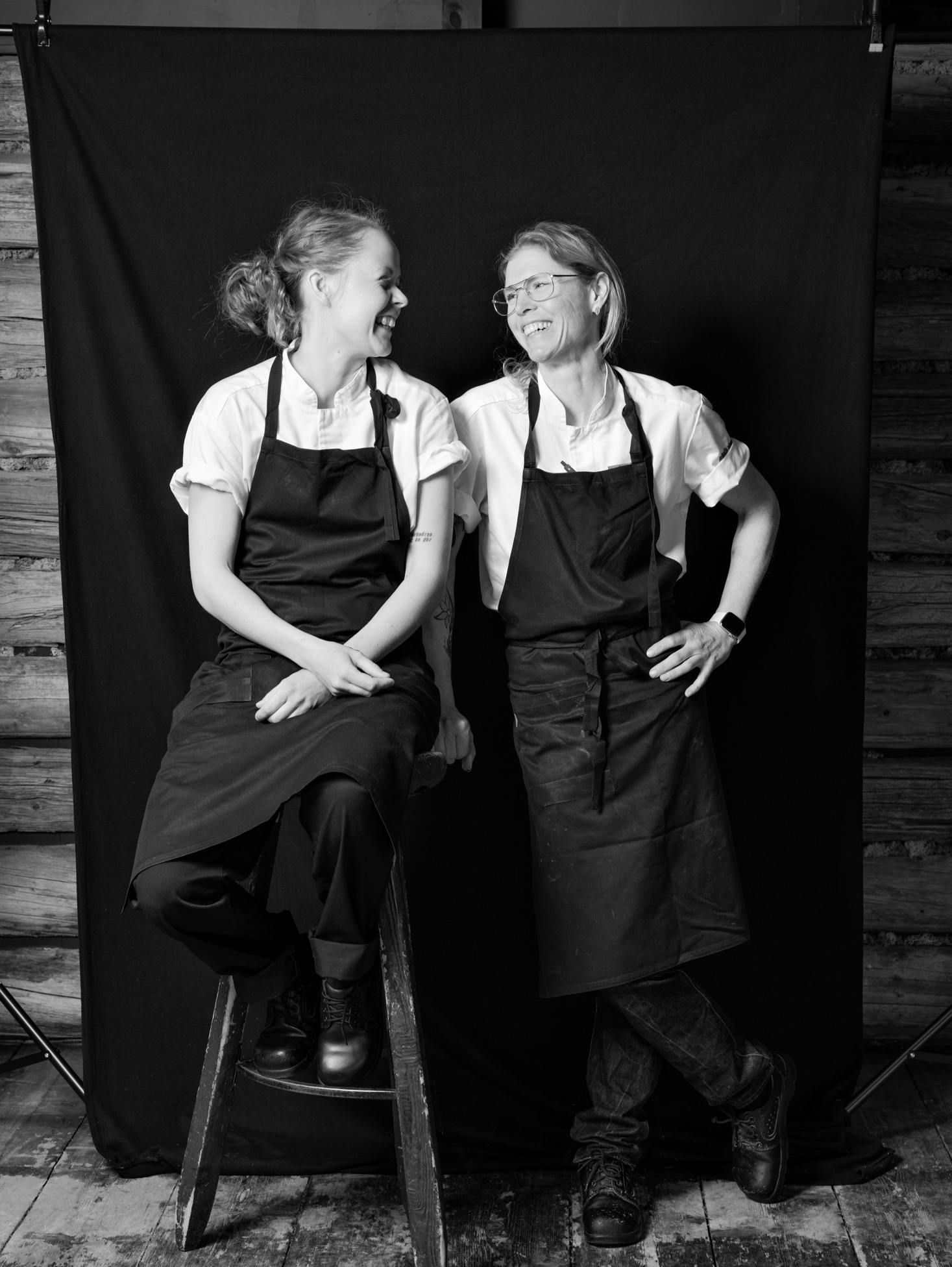Flavours of the Swedish Mountains at Buustamons Fjällgård
Meet the women behind the lauded restaurant at Buustamons Fjällgård, a rustic hotel perched on the side of a Swedish mountain.
Words by Sophie Miskiw. Photography by Johan Ståhlberg.
If asked to pick one Swedish proverb that best sums up the Swedes a good contender would be: ‘There’s no such thing as bad weather, just bad clothes’. Come snow or shine, the Swedes are a nation of people who inherently value nature and embrace outdoor living.
Lucky for them, then, that Sweden has an abundance of everything they need to tick these boxes. And it can all be found at Buustamons Fjällgård, a rustic hotel halfway up a mountain in Sweden’s scenic Jämtland region.
“It’s very beautiful up here,” says Lovisa Björkenstam, head chef of Buustamon’s renowned restaurant. “We’re quite close to the main ski resort Åre, but still somehow in the middle of nowhere. In the summertime, you can drive all the way up because the road is quite good, but in the winter you need to ski or take a snowmobile.”
With help from her right-hand woman, chef Olivia Bengtsson, Lovisa is responsible for running the widely-praised restaurant at Buustamons Fjällgård. Together, the pair devise dishes that reflect the mountain’s changing seasons and conjure a gastronomic picture of the rangy region.
“We have a lot of guests who come from the southern part of Sweden, and pre-Covid we used to have a lot of guests from Europe. So we cook Swedish food with influences from all over the world,” explains Lovisa. “But we try to keep the flavours local so people feel they are in the Swedish mountains. We work a lot with Arctic char and reindeer because it can seem quite exotic to the guests.”
‘Summertime is almost as good as the winter’
A seven-hour drive north of Stockholm, Jämtland is a region of stunning scenery, copious local culture, and sustainable gastronomy. Perhaps best known for Åre, one of Scandinavia’s leading ski resorts, there’s more to this majestic province than the slopes, and visitors are lured in by its natural tranquility throughout the year.
“The hotel is quite full all the time, it’s really popular. I think it’s a trend to come up here to do things like hiking and cycling,” says Lovisa. “I think the summertime is almost as good as the winter. It’s just shorter!”
Being somewhat at the whim of the Alpine climate naturally influences the menu at Buustamons Fjällgård. Inspired by the seasons, Lovisa and Olivia create lighter, fresher dishes in the spring and summer, transitioning towards more substantial comfort food as the colder weather sets in. Wherever possible, they use locally sourced ingredients - plenty of which they grow or forage themselves.
“Olivia has really green fingers,” praises Lovisa. “So we grow things inside and then when it gets warmer and the sun comes out, we move the plants outside. In August and September, we have plenty of things growing…we just need to put them on the right side of the building where the sun will reach them!”
There are, as Lovisa alludes to, obvious challenges to working this way when you’re situated just south of the Arctic Circle. Sweden in the summertime offers a cornucopia of fruit and mushrooms just asking to be foraged. In the winter, not so much. But after centuries of surviving long subarctic winters, the Swedes are more than accustomed to gathering what they can in the summer and storing it to use later that year.
“We pick plenty of lingonberries and raspberries in the summertime and freeze them to use in winter,” says Olivia. “Cloudberries too are really popular up here. They’re the gold of the mountain!”
An ecosystem of local producers
For guests to experience an authentic taste of the Jämtland region, Lovisa tries to source as much produce as possible close to home. Jämtland has a well-connected ecosystem of local producers she can call on throughout the year for everything from locally-caught Norwegian Arctic char to gamey meats like reindeer and venison.
“We have so many people up here who are really creative and make a lot of good produce,” says Lovisa. “They make cheese, we have a local guy who makes chocolate…there are lots of fantastic producers up here.”
One product she doesn’t have to look too far to find is aquavit, Sweden’s infamous national spirit. Buustamons Fjällgård is one of the smallest legal distilleries in Sweden and has produced its own range of aquavit for some 20 years. Infusing the liquor with flavours from the surroundings, like fennel and spruce shoots, it’s just the tipple to enjoy ‘when in Jämtland’.
“We use the things around us to make it,” says Lovisa. “For example, fennel and spruce shoots which are typically Swedish ingredients found in Jämtland. We even cook with it! We flavour the lingonberries or some sauce with it, or use it when we cure venison or reindeer.”
This approach to making the most of every available ingredient is a cornerstone of the creativity of Buustamons Fjällgård. In the kitchen, Lovisa and Olivia try to use each ingredient in a range of ways to avoid food waste, such as using the stem of parsley in a pesto or pickling leftover carrots. Olivia admits this way of working was new to her when she first started at the restaurant, but now, she concludes, there’s no going back.
“It feels like we take care of the food in a much better way. Working in this way is much more genuine.”
Words by Sophie Miskiw. Photography by Johan Ståhlberg.
